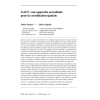Free Online Productivity Tools
i2Speak
i2Symbol
i2OCR
iTex2Img
iWeb2Print
iWeb2Shot
i2Type
iPdf2Split
iPdf2Merge
i2Bopomofo
i2Arabic
i2Style
i2Image
i2PDF
iLatex2Rtf
Sci2ools
RIA
2006
2006
GACS : une approche ascendante pour la coordination spatiale
ABSTRACT. The design of spatial coordination mechanisms for dynamical and continuous multiagent setting is a difficult challenge. While the top-down decomposition approach is inefficient on such problems, the bottom-up approach is more promising, but requires a tedious manual parameter tuning which raises scaling-up issues. Our own approach consists in replacing the manual tuning by a specially designed multicriteria evolutionary algorithm devoted to the tuning of our spatial coordination formalism. In this paper, through a quantitative comparison on a complex spatial coordination problem treated previously by Balch and Hybinette, we show that our system, GACS, finds a population of solutions as efficient as this predecessor though our approach requires less involvement from the designers and can find simpler solutions. MOTS-CL
RIA 2006 | Spatial Coordination | Spatial Coordination Formalism | Spatial Coordination Mechanisms |
| Added | 15 Dec 2010 |
| Updated | 15 Dec 2010 |
| Type | Journal |
| Year | 2006 |
| Where | RIA |
| Authors | Fabien Flacher, Olivier Sigaud |
Comments (0)

